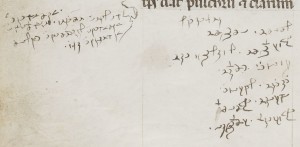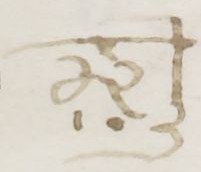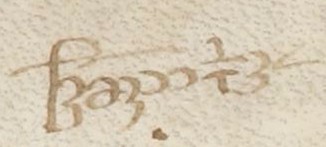I mentioned the manuscript BNF Cod. Fonds Latin 7272 in a recent post, specifically because it contains various books on astronomy and astrology by the 13th century Genoese nobleman Andalò di Negro.
Interestingly, though, it also contains a large set of marginalia in what appears to be an entirely unknown alphabet: whoever contributed these added them only to Andalò di Negro’s “Introductio ad judicia astrologica” (folios 100 to 170). These marginalia look like this:
I’ve put a complete set of these on a Cipher Foundation “Paris 7272 Cipher” webpage.
BNF Cod. Fonds Latin 7272
According to the BNF’s catalogue entry (prepared in 2011), this manuscript was formerly in “la bibliothèque des rois Aragonais de Naples”, before being seized from Naples by Charles VIII in 1495 and transferred to le château d’Amboise. Subsequently it was transferred to the French Royal Library in Blois round about 1500 (it was described in a 1518 inventory there), and from there to the Royal Library in Paris (it was also listed in a catalogue there at the end of the 16th century).
The BNF’s notes also mention “Nombreuses notes marginales de plusieurs mains”, and specifically wonder whether the ones on “ff. 112-113v, 114v 116v, 117v, 118v, 143, 161-164” – the ones we’re interested in here – might be “indications mathématiques (astronomie?)”, presumably because some of the signs resemble fraction (e.g. 1⁄3, etc).
Because the section where these marginalia appear is completely devoted to judicial astrology, my initial speculation about these marginalia when I first blogged about this in 2009 (though back then I only had low-quality photocopies of a few scans taken from the Warburg Institute’s Photographic Collection, not really enough to work with properly) was that they were actually some kind of astrological shorthand. (I also suspected it was “Florentine”, though I have no idea what led me to conclude that.)
Yet now that I have seen the whole set, I really don’t know. For one, many of the lines appear to be right-justified, which suggests to me that these may well have all been written from right to left. For another, just about every piece of marginalia on late pages includes the following curious shape at the end of a line, which looks more like some kind of hybrid Arabic calligraphy version of the conventional “item” / “ytem” / “ibidem” paragraph marker.
And for another, there are plenty of consistent letter contacts, as well as plenty of words which appear to recur, e.g.:
Any thoughts?




Highly interesting!
The library mentions numerous marginalia in several hands, but I guess that the other hands are largely in other parts of the MS. I only noted some obvious cases on f162v.
Some patterns appear very frequently.
My first impressions are:
– written right to left
– mostly numbers
– looks like shorthand more than cipher
Rene Z: most of the other marginalia are in broadly the same kind of hand as the main text – the “Paris 7272” marginalia I’m interested in really are quite different from them. Despite the resemblances to common number forms (e.g. ‘2’ and ‘3’), I remain far from convinced that these are numbers: after all, the Voynich Manuscript uses plenty of number-like shapes but (like almost all of the other cipher alphabets from the first half of the 15th century) derived from non-numerical shape usage, so why should these be?
And as to whether or not this is a shorthand: the date (even a conservative pre-1500) would seem to be wrong for this. And besides, once you get the hang of ‘reading’ it off the page, it uses a fairly compact set of letter shapes for its alphabet. I’ll try and map these out for a future post, you’ll see what I mean (I hope). 🙂
You have posted some excellent stuff recently Nick (and I will not deny that I had a brief chortle at the weaknesses of Cryptocrack).
I think this may just be extremely cursive handwriting larded with abbreviations, numerals and astronomical symbols. The marginalia between pages 112 and 143 refer to the Zodiac signs from Aries to Leo and the rest the 28 mansions of the moon (sometimes with star diagrams – 162r/5 looks like the Hyades). Clearly they provide additional astronomical data: possibly celestial coordinates or the like.
Hi, Nick–
Some of these letters remind me of those used in the Blitz Cipher. It might be of interest to compare them.
Robert: thanks, I’ll have a look…
I see some similarities with some form of cursive Hebrew.
https://en.wikipedia.org/wiki/Cursive_Hebrew
(there are better illustrations of it around).
Philip: that’s what I first thought back in 2009, but now I’m not so sure. The right to left writing sits awkwardly with it: there seems to be too few letter shapes to support both an alphabet and a full set of digits: the date (I’m guessing 1400 or so?) may be a little early for Arabic digit shapes: and so on. But this is still too handwavy: I’ll try transcribing it over the next few days and see where that leads…
Philip: as far as Cryptocrack goes… I think that we were looking at what historians like to call “Italianate Latin”, which very probably has quite different statistics and letter contacts (not just an extra letter ‘z’ etc), so it’s perhaps no wonder Cryptocrack was having difficulties until it found a chunk of properly Latin text to get its statistical teeth into. 🙂
Rene: I didn’t see that at first at all, but perhaps you are right – it was certainly written in a hasty, non-secretarial hand, so all kinds of scrappy shortcuts are possible. I’ll certainly bear that in mind when I try to transcribe it etc.
Nick: How can you be sure of the marginalia dates? Are they recorded as being there in the 1518 inventory, or in the late 16th century inventory you mention?
I’m asking because the French have historically been quite fond of “stenographie”, devising several systems: check out the French wikipedia page for a chronological list of these “stenographie” systems by country, its more complete than in the english version.
The notes (or at least some of them) could have been added quite a bit later than the period you are considering, when such systems really became popular, especially in university contexts and in legal note-taking, and this is precisely a book about judiciary astronomy/astrology.
Goose: I’m not at all sure of the date and would welcome a second/third opinion. To my eyes, though, the letter shapes don’t at all resemble the letter forms of the 16th century or beyond, but look closer to what I would expect for circa 1400. And also: on 143r, there’s what looks to be an additional piece of marginalia from the early-to-mid 15th century that was written in the clear space just below the other marginalia, which suggests to me that this extra marginalia was probably written after the date of the main set of marginalia we’re interested in. http://cipherfoundation.org/wp-content/uploads/sites/4/2016/02/143r-marginalia.jpg (What does this say? Any suggestions?)
As normal, none of these pieces of evidence is hugely strong on its own, but I suspect that the reasoning linking them all together probably does hold up OK.
Just an observation, but on the Wiki page for cursive Hebrew, there is a table with 14 columns, showing the progression of the script. Column 5 contains “Spanish 1480” which has a match for a lot of letters in the code and it also matches the time period. Note the unique way the Hebrew letter shin is written as a capital Roman F, which is also present in the marginalia.
Just saw numbers like these on Nepalese firearms… It’s called Devanagari script.
Upside-down and backwards? Fortunately, I have a good-size hand-held mirror. The reflectioned script seems, to me ennyway, to be a more sensible piece of reading.
Nick- I put a link to the cipher foundation page up on a french stenographie forum, and so far they say: not stenographie (they also said not a cipher), and suggested an ancient language such as greek minuscule. Which would give more weight to Rene and John Willemse’s idea of old cursive hebrew or other such possibilities.
I’ll update if I get any different replies.
Goose: Bright’s (1588) Characterie was the first modern shorthand, more than 150 years after the kind of date I’m comfortable with for this… so I’m not hugely surprised about the stenographie.
I plan to map the alphabet and transcribe at least some of it in more detail, because there may be something ‘obvious’ (i.e. glaring) we’re missing about it…
Hello Nick, thank you for sharing this interesting manuscript!
I think I might have made some progress with the marginalia. See:
https://stephenbax.net/?p=1198#comment-164628
Marco: I do believe you’ve cracked it, very well done, excellent work! I’ll try to post a more complete write-up over the weekend as a fresh post (rather than just as comments)…
I’m puzzled as to which direction (from left to right — or right to left). Not necessarily ‘mirror’ writing, but rather an attempt to not smudge the freshly written letters?
ps: I am a southpaw. I first wrote typically of a left-handed writer (wrist overhand) — until my teacher loosely bound my elbow to my waist.
Try it, just for fun!